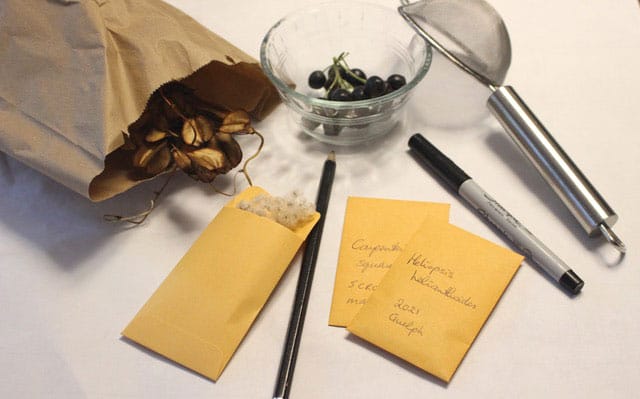GUELPH – Saving seeds from vegetables and flowers is a great way to save money and share with others.
The first thing to consider is what seeds to save.
Choose plants that are open pollinated and not hybrid as hybrids do not come true from seed and may not produce viable seed.
Some plants, like carrots and beets are biennial; they grow roots and leaves in their first year then flower and set seed the second year.
To collect their seeds, leave a few plants to overwinter and flower the next year.
Some plants produce seeds in the flower head. Others produce pods or fruit; the seed-containing parts must be left on the plant and not harvested until the seeds are mature.
Mature seeds are plump and often change colour as they mature.
For flower head seeds like sunflowers, wait until any petals have dropped and the flower starts to dry.
For pods like peas or beans, the seeds are mature when the pod dries and the seeds inside rattle.
Moist fruits like tomatoes or squash can be left on the plant until overripe to ensure seeds have matured.
Harvesting dry seeds
Harvesting dry seeds is easy; cut the flower heads or seed pods when the seeds are plump but not quite mature and place into a paper bag labeled with plant name and date.
Store the bags in a warm dry place for several weeks until the seeds dry and start to shed; you may need to break open the pod or rub the flower heads to free the seeds.
Clean the seeds by picking out the larger pieces of chaff then shaking through kitchen strainers with various sizes of mesh.
Harvesting seeds from moist fruit
Seeds from moist fruit need special treatment. Choose clean, disease free, completely ripe fruit.
Cut open the fruit and squeeze or scoop out the seeds into a clean container and cover with water. Let the seeds ferment for a few days, stirring daily to separate the pulp.
When the mixture is frothy, pour off any floating seeds and pulp but retain the heavy seeds at the bottom.
Add water to the container, allow the seeds to settle then pour off again several times to remove as much pulp as possible.
Drain the seeds then spread on paper towels or coffee filters to dry, ensuring that seeds do not touch one another. When seeds are fully dry, shake them off the paper into a container.
Cleaned and dried seeds should be stored in paper, not plastic. Coin envelopes work well.
Label each envelope with plant name, date, and a description. Store the envelopes in a box in a cool, dry place. Avoid plastic storage containers; if the seeds are not totally dry, they may develop mold.
Sharing seeds
Seeds can be shared and exchanged at Seedy Saturday events in Fergus, Erin and Guelph or through the Wellington County, Erin or Guelph Seed Libraries.
Wellington County Seed Library: wellington.ca/en/discover/seed-library.aspx
Erin Seed Library: erinseedlendinglibrary.weebly.com
Guelph Seed Library: guelphtoollibrary.org/guelph-seed-library
Master Gardeners are certified horticultural experts who provide gardening information to the public on a volunteer basis.
Contact us for free advice at gwmastergardeners@gmail.com or call us at 519-824-4120 ext 56714
***
Written by Judy Brisson, Guelph and Wellington Master Gardeners




